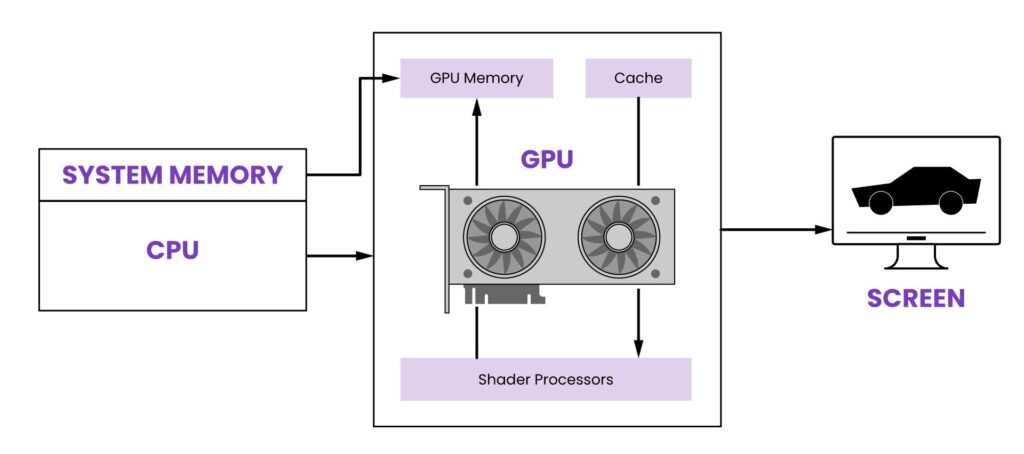What Is GPU? Understand the essential role of Graphics Processing Units in modern computing. This guide explains how GPUs enhance visuals, support gaming, drive AI innovations, and differ from CPUs. Gain insights into GPU architecture and performance benefits.
This article explains the fundamental principles of GPUs, detailing their architecture, core functions, and distinctions from CPUs and graphics cards. It also covers various GPU types, their applications, and emerging trends in GPU technology.
Why Are GPUs Important?
Graphics Processing Units (GPUs) are integral to modern computing due to their specialized architecture designed for parallel processing. Unlike Central Processing Units (CPUs), which are optimized for sequential task execution, GPUs can manage numerous operations concurrently.
This capability is essential for rendering complex graphics, executing data-intensive computations, and accelerating machine learning algorithms. In academic research and industry applications alike, GPUs facilitate rapid data processing, making them indispensable for tasks that require high computational power, such as real-time simulations and large-scale scientific analyses.
Their role in advancing technologies—from artificial intelligence to high-performance computing—underscores their critical importance in both theoretical and applied disciplines.
How Does A GPU Work?
A GPU is designed for parallel processing, using many small cores grouped into streaming multiprocessors to execute multiple operations concurrently. Unlike a CPU’s sequential approach, a GPU divides complex tasks—such as high-resolution rendering or data-intensive computations—into smaller, parallel tasks distributed among its cores.

This architecture is particularly effective in graphics processing, scientific simulations, and machine learning. Moreover, integrated high-speed VRAM enables swift data access, while efficient memory management and specialized scheduling further enhance performance in environments requiring simultaneous processing.
What Are The Different Types Of GPUs?
1. Integrated GPUs
Integrated GPUs are built into the CPU or chipset, providing basic graphics capabilities. They are energy-efficient and suitable for general computing tasks but lack the power needed for high-performance applications.
2. Dedicated (Discrete) GPUs
Dedicated GPUs are separate hardware components with their own VRAM, designed for demanding tasks like gaming, 3D rendering, and professional graphics work. They offer superior performance compared to integrated GPUs.
3. External GPUs (EGPUs)
External GPUs connect to a computer via high-speed interfaces, such as Thunderbolt, to enhance graphical performance. They are commonly used in laptops that require additional GPU power for tasks like video editing and gaming.
4. Data Center And Hpc GPUs
These specialized GPUs are optimized for artificial intelligence, machine learning, and large-scale scientific computations. They feature advanced parallel processing capabilities and are used in high-performance computing environments.
What’s The Difference Between A GPU And A Cpu?

| Aspect | Central Processing Unit (CPU) | Graphics Processing Unit (GPU) |
| Architecture | Comprises a few powerful cores designed for sequential task processing and general-purpose computing. | Contains hundreds or thousands of smaller cores organized for simultaneous, parallel task execution. |
| Processing Type | Optimized for sequential processing, managing diverse tasks with high flexibility. | Specializes in parallel processing, ideal for tasks that require handling multiple operations concurrently. |
| Task Specialization | Suited for a broad range of operations, including running operating systems, applications, and handling single-threaded processes. | Primarily focused on graphics rendering, data-intensive computations, and tasks such as scientific simulations and machine learning. |
| Memory Management | Utilizes a hierarchical memory system (L1, L2, and sometimes L3 cache) to manage a variety of data streams efficiently. | Often equipped with dedicated high-speed memory (VRAM) to support rapid data access and the large bandwidth required for graphics processing and parallel computations. |
| Applications | Essential for general computing tasks, executing software applications, and managing system-level operations. | Integral to rendering high-resolution graphics, accelerating complex computations in scientific research, AI, and real-time simulation tasks. |
| Flexibility | Provides versatility in processing a wide array of computational tasks, from basic applications to complex algorithmic computations. | While less versatile in handling non-parallel tasks, its specialized design makes it highly efficient for scenarios that benefit from massive parallelism. |
What’s The Difference Between A GPU And A Graphics Card?
A GPU is a specialized processor engineered to execute parallel computations, making it highly effective in tasks such as graphics rendering and complex mathematical operations. In contrast, a graphics card is a complete hardware assembly that incorporates the GPU along with other critical components necessary for optimal performance, including dedicated memory, cooling solutions, and power regulation circuits.
1. Key Components of a Graphics Card:
- Dedicated memory (VRAM)
- Cooling solutions (e.g., fans, heat sinks)
- Power regulation circuits
- Connectivity interfaces (e.g., ports, bus connectors)
2. Functional Distinctions:
- The GPU is the core chip that executes intensive computations.
- The graphics card integrates the GPU into a form factor that is compatible with a computer system.
3. System Integration:
- The graphics card facilitates communication between the GPU, CPU, and other system components.
4. Terminology Clarification:
- While the terms “GPU” and “graphics card” are often used interchangeably, the GPU is the processing unit within the broader graphics card assembly.
What Future Trends Are Expected In GPU Technology?
Future trends in GPU technology are likely to focus on enhancing parallel computing and specialized processing. Future designs may include more cores and faster memory to handle complex tasks efficiently.

GPUs are also expected to integrate dedicated accelerators for artificial intelligence and machine learning, improving deep learning and real-time processing. Innovations such as advanced ray tracing will boost visual quality in graphics, while better power management and thermal design will allow GPUs to operate effectively in energy-sensitive devices like mobiles and edge systems.
Additionally, the merging of GPU and CPU functions may lead to more versatile processing solutions, with GPUs playing a larger role in cloud computing and high-performance data centers.
FAQ’s
1. What Is The Primary Function Of A GPU?
The primary function of a GPU is to accelerate the processing and rendering of graphical data through parallel processing techniques. This capability is essential for high-performance applications such as image rendering, scientific simulations, and artificial intelligence computations.
2. Which Applications Benefit Most From GPU Acceleration?
Applications that benefit most from GPU acceleration include image and video processing, machine learning, and scientific simulations. These tasks leverage the GPU’s parallel processing capabilities to efficiently manage large data sets and complex computations.
3. How Do I Decide Which GPU Is Right For My Needs?
Deciding on the appropriate GPU requires evaluating your specific computational demands, such as the need for parallel processing power and memory capacity, alongside budgetary constraints. Consulting benchmarking data and academic research can further guide an informed selection tailored to your application requirements.
4. How Much GPU Do I Need?
The necessary GPU capacity depends on the complexity of your computational tasks and performance requirements; evaluating workload benchmarks and application-specific demands will help determine an optimal selection.
5. Do Laptops Have GPUs?
Yes, laptops typically have GPUs, either integrated into the CPU for basic tasks or as dedicated discrete GPUs for higher-performance applications such as gaming and video editing. The configuration depends on the laptop’s design and intended use. for a couple of seconds
Most modern laptops incorporate GPUs, either as integrated components within the CPU or as discrete units designed to deliver enhanced graphics and computational performance.
Summery:
GPUs are vital in modern computing, offering efficient parallel processing for graphics rendering and data-intensive tasks. They differ from CPUs by handling multiple operations simultaneously, and their various types serve a range of applications from everyday use to high-performance computing. Understanding these differences helps in selecting the right GPU for specific needs. Future advancements promise even greater integration and performance improvements.




